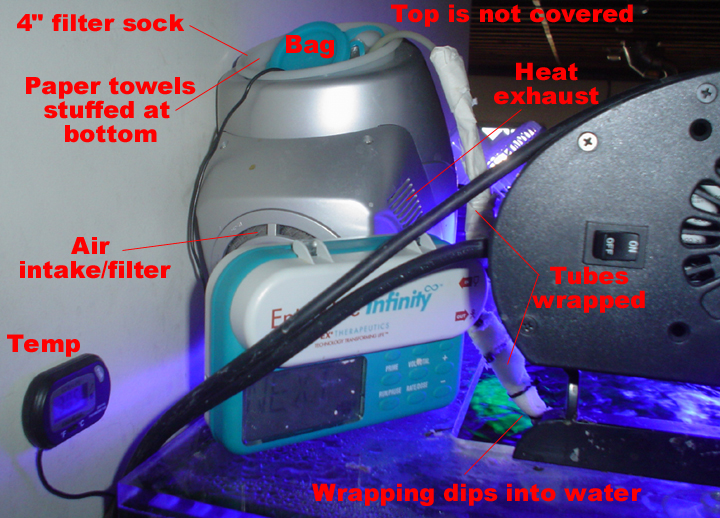In my year of usage, I've refined things a bit:
1. I'm only feeding blended oysters now. Is much simpler, and cheaper, and covers all particle sizes from 1 to 200 microns. Most important: Oysters STAY SUSPENDED. Most other foods will settle to the bottom and clog the tubing. I'm using Reef Nutrition Oyster Feast, but similar would be fine. This food will stay suspended a whole month without touching it!
2. I don't get the air out of the feeding bag first.
3. Put a 4" filtersock in the chiller first (fits perfectly, and covers the icy cold steel wall). Then put a 1/2" or so of paper towel on the bottom, to keep the bag off the very-cold bottom area. Then just lightly put the bag in. No need to cover the top if you leave the chiller on "continuous".
4. Wrap the tubing to keep light and heat away from it, especially the heat from the chiller. Also, for the part of the tubing that goes from the pump to the tank, if you wrap it with a thin towel and let the towel touch into the tank water, the water will keep the towel wet, and therefore keep it cool.
5. Clean the air-filter on the chiller periodically.
6. For NPS, especially any seafan, put them near and in the direct flow of a powerhead. Even though the polyps may look like they are bending out of shape, they are still getting the most food this way.
7. Super high flow throughout the display, and sump, is critical. You don't want anyplace where the flow stops, since the food will settle out. While settling may help feed the snails, it won't help the corals.
8. Keep a thermometer in the chiller, which you can see while walking by. It stays between 28 and 33 degrees F. The food won't freeze as long as you have a filter sock covering the walls, and have paper towels stuffed at the bottom, and don't cover the top.
Misc:
I once turned off the feeder (but kept feeding the fish/eel) for a month. Every NPS died, along with some other corals, within 3 weeks. The notable exception was a copper colored flower pot that thrives. I never target fed, and won't.
The medical pump has been found on ---- for as little as $100 USD.
Get a backup chiller. They are cheap, but not sturdy. I had one go out.
Continous feeding puts a ton of food into the water, so start doing it SLOWLY, maybe just 1.0 ml per DAY (not per hour), to see if your Nitrate and Phosphate filtration can keep up. It takes about 3 weeks for the effects of the excess food to show up as increased Nitrate or Phosphate or nuisance algae, so don't think you can increase it each day because you are not seeing any problems yet. If after 3 weeks there is no Nitrate and Phosphate or nuisance algae problem, then slightly increase the feeding amount. There is no limit to how much your corals can eat; the limit is how much Inorganic Nitrate and Inorganic Phosphate filtering you have. If you are designing a system to have a continuous feeder, and a scrubber, then the bigger the scrubber the more you can feed. I'm currently feeding 4.0 ml/day total, for 100 gal. This of course does not include the fish food (about 8 square inches of nori per day), or the eel food (one silverside per week).

